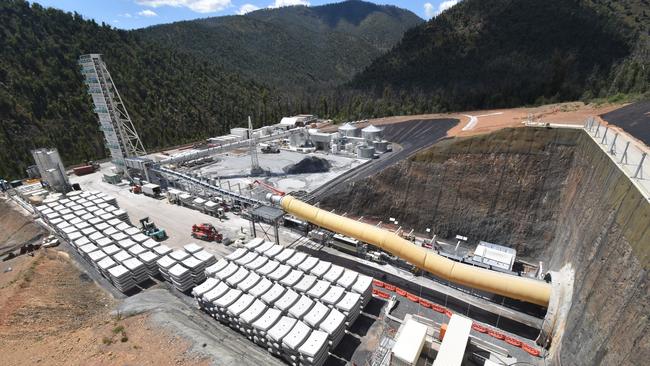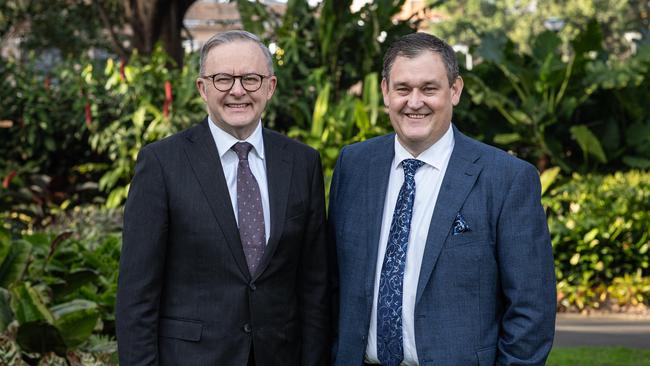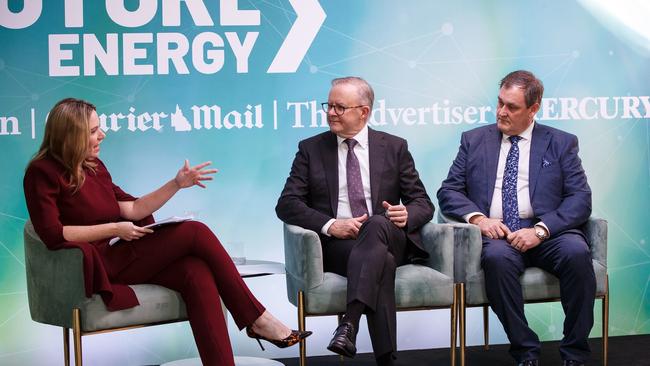Huge cost of Australia’s renewable energy dream, according to industry leaders
Energy industry leaders have revealed the race to connect renewables to the grid is challenging and costly as projects blow out by billions.

Environment
Don't miss out on the headlines from Environment. Followed categories will be added to My News.
The race to connect renewable energy to the grid is challenging and costly, industry leaders say, as they urge a focus on affordable electricity.
Alinta Energy chief executive officer Jeff Dimery said his firm was investing $10bn into renewable power, including offshore wind, battery technology and pumped hydro, but cautioned that affordability must remain a key driver.
He cited the giant Snowy 2.0 pumped-hydro project, the cost of which in August was announced as having blown out to $12bn from an original $2bn.

Mr Dimery said this would deliver $100m of monthly revenue once complete, which translated to a capital cost of more than $60 per megawatt hour.
The market paid less than $15 per megawatt hour for pumped hydro less than three years ago – a more than fourfold cost hike.
“We need to clean up our energy supply..... And I guess what I’m saying is that, ultimately, I agree with the Prime Minister, his vision and how we need to get there. Where we’re differing is at the pace at which we might do that,” Mr Dimery said.
Transgrid executive general manager Craig Stallan, whose firm operates and manages the high-voltage transmission network in NSW and the ACT, said infrastructure needed to be built to create a superhighway across the national power grid.
This would enable electricity to be shared much more easily and, therefore, boost energy security.
Mr Stallan cited figures showing every dollar invested in transmission infrastructure returned $2 to consumers pockets.
He likened the electricity network to a heartbeat, saying the grid ran at 50 beats per second and this had historically been maintained by coal-fired generators.
“As we change away from that infrastructure, the strength of that system is going to change and we need to replace that load with other technologies so that wherever you are on the grid, you can still hear that heartbeat, you can synchronise to that heartbeat, and you can get that nice, stable operating pattern,” Mr Stallan said.

Prime Minister Anthony Albanese said extending the transmission network was vital to enable business and industry to “access reliable and affordable clean energy to reduce their input costs and reduce their emissions”.
“Some of the best places in the country for wind and sun, and the jobs that go with it, are off the grid today. That needs to change,” he said.
“ The investments we are making, upgrading the national energy grid, will create new jobs on major projects right around Australia.
“That will ensure that the next generation of Australian jobs in advanced manufacturing technology and critical minerals can be powered by renewable energy as part of our quest for a grid fit for the 21st century and beyond.”
Click here to find all the stories in Future Energy campaign
Everyday life in households will be dramatically changed by the unprecedented energy transformation, which will affect everything from plugging in electric cars to cooking.
The Future Energy forum heard charging cars was like setting an alarm clock, while it would take time for households to make choices to electrify their kitchens.
Australian Energy Council chief executive Sarah McNamara, who represents electricity generators and retailers, said a smart meter rollout would help more households be open to buying electric vehicles and home batteries.
“But I think we also need to be realistic about electrification and that it is going to take time for households to make choices to electrify their kitchen, for example, and that’s not just a preference issue, that’s often an affordability issue,” she said.
“A lot of households simply don’t think about electricity that much. They worry about paying their bill, but it’s a bit of a grudge purchase.
“Trying to get those people excited about investing in new technologies, supposing they can afford it, is a real challenge and that will take us time.”
Ms McNamara urged measures to help low-cost housing become energy efficient and install solar panels on rental properties.
EV Direct chief operating officer Mark Harland, whose firm imports BYD electric vehicles, said people needed to be educated about the ease of charging electric cars, likening this to setting an alarm clock.
“Most of us drive 30 to 40km a day and, say, using maybe seven or eight kilowatts of a 60kW battery. So I go home at night I could plug into either a charger or I could just plug it into the normal 15 240 (outlet) and charge that in a few hours,” he said.
“The battery range anxiety and the costs of that is changing really quickly with the technology.”





